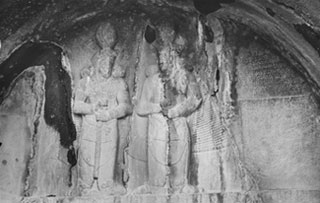Click on any hotspot to learn more about the Shapur Plate

The king depicted on this plate is generally identified as Shapur II (reigned 309–379 CE) because of his distinctive crown, which is also found on coins minted during his reign. Shapur II expanded the Sasanian Empire from the borders of China to the Mediterranean, and his reign corresponded with that of the Roman emperor Constantine (306–337 CE). One of history's longest reigning monarchs (seventy years!), Shapur was said to have been crowned king while he was still in his mother's womb.
Investiture Relief Picturing Shapur II and Shapur III; Iran, Taq-i Bustan, Small Vault; Photographic glass plate negative; Ernst Herzfeld Papers, FǀS Archives FSA A.6 04.GN.2783

The hunt symbolized power and kingship in the Ancient Near East. In this hunting scene, the king calmly aims his bow and arrow at the upper boar, showing his control over chaos. The lower boar is already dead. Such plates were meant as gifts for the elite, but similar scenes of kings hunting boars were also carved into large rock reliefs at Taq-i Bustan in northwestern Iran. Intended as a public monument, the elaborately designed relief depicts a king hunting hundreds of wild animals using horses, elephants, and boats. It is not only a display of skill and power but also a literal depiction of the king's favorite sport, one in which he indulged at the hunting parks around Taq-i Bustan.
Detail, Relief Panel Depicting Boar Hunt; Iran, Taq-i Bustan, Large Vault; Photographic glass plate negative; Ernst Herzfeld Papers, FǀS Archives FSA A.6 04.GN.1874
Shapur II wears the tradition royal garb, including a riding coat (kaftan) and long pants, with a crown, a lobed earring, and a ceremonial sword and belt. The combination of kaftan and pants, designed for agility in riding, originated during Iran's nomadic past.